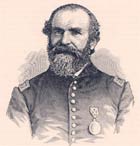 Open main menu
Open main menu
 Open main menu
Open main menu

J. Roemer
(1818 - 1896)
Home State: New York
Command Billet: Battery Commander
Branch of Service: Artillery
Before Antietam
Roemer had served in the German Cavalry but "purchasing his discharge" emigrated to New York City in 1839, making his home in Flushing in 1842. He enlisted in the Hamilton light artillery (Flushing Guards, Flushing Battery) - a New York militia unit - in 1845 as a private, entered Federal war service with them as Lieutenant in June 1861, and was commissioned Captain after the battery's reorganization in the Spring of 1862.
The Captain and his battery first saw action at Cedar Mountain on 9 August, then were engaged at Second Manassas at the end of the month, where Roemer was wounded.
On the Campaign
Roemer in command at Antietam, the battery supported the attack on the Lower ("Burnside's") Bridge on the 17th, reporting two men wounded and three horses killed in action.
The rest of the War
After Fredericksburg, the battery and the rest of the Ninth Corps followed Burnside to the Western Theater, with service at Vicksburg and Jackson, Mississippi in July 1863, and significant combat experience at Knoxville in November, about which the following anecdote appears in a post-war account:
On the night before the attack it was found that but little available ammunition, except some shells that had been buried by the rebels and dug up by our forces, could be found; and that these had corroded, so that but few exploded. Captain Roemer called for a volunteer to assist him in boring out the fuses of these shells, a work fraught with great danger. Sergeant Kauffman, of the 46th N.Y., immediately consented to help, saying that if the captain could afford to risk his life he could. Taking their ammunition box they crept close under the shelter of the ramparts to avoid the chance of a flying shot, and were busily engaged when a shell from a rebel battery struck the rampart and exploded, covering them with dirt and destroying the ammunition box, containing twelve shells, which, fortunately for the garrison, did not explode. The sergeant mildly remonstrated:
"Captain, if you keep on you'll blow us all up."
"Never mind," said the captain. "Better be blown up here than go to Richmond."
"All right, captain, just as you say,"
... It was this incident of coolness and self sacrifice that had reached the ear of the commanding general [Burnside]...
After the War
After the War, Major Roemer was a successful boot and shoe dealer in Flushing, which had also been his pre-war occupation. His family published his memoir, "Reminiscences of the war of the rebellion 1861-1865" at Flushing in 1897.
References & notes
Unit information, biographical detail and Roemer's face, above, are from the History of Queen's County1. His own summary of life and service is found in the 1867 report of the New York State Bureau of Military Statistics, online from GoogleBooks. His brief obituary was published in the New York Times of 17 July 1896.
Birth
04/03/1818; Darmstadt, Hesse, Germany
Death
07/16/1896; Flushing, NY
1 Munsell, W.W. & Co., History of Queen's County (New York), New York: W.W. Munsell & Co., 1882, pp. 74-143 [AotW citation 832]